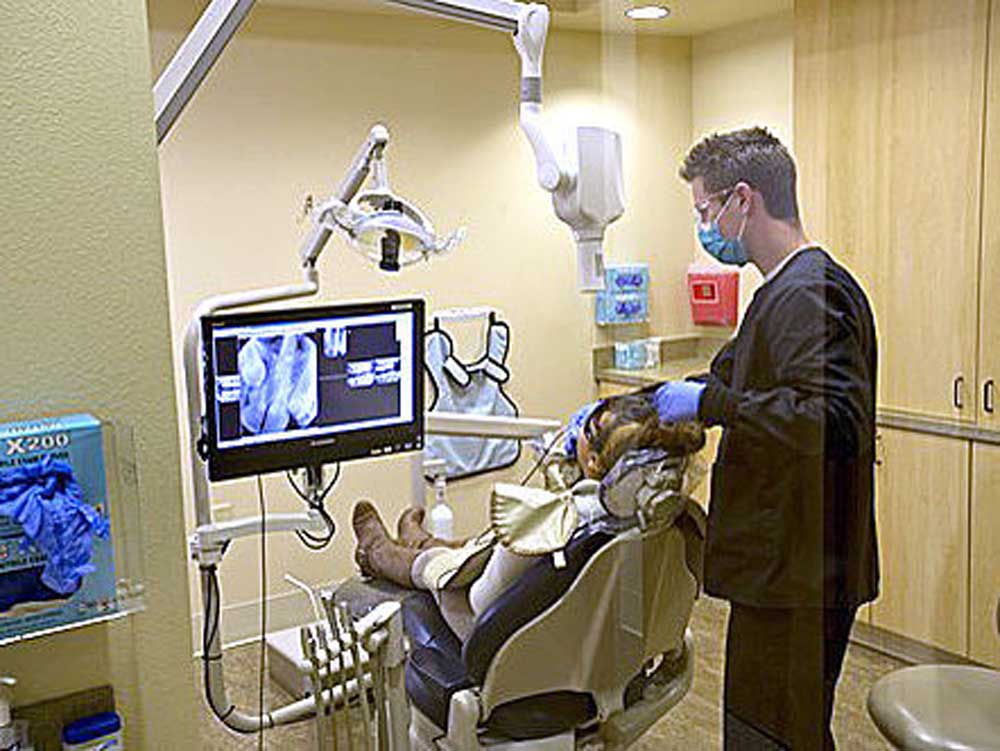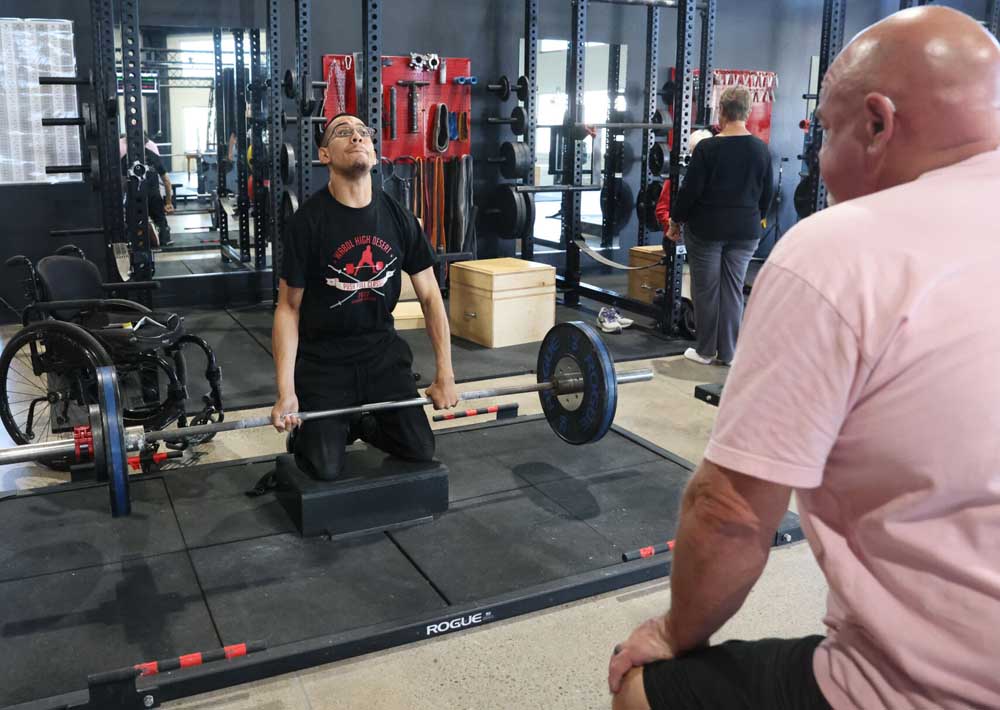The dentist who laid down his drill
Published 12:00 am Monday, February 15, 2016

- Ryan Brennecke / The BulletinDental hygienist Adam McFarlin takes an X-ray of Malaree Jaynesí teeth during her appointment at Advantage Dental Clinics in La Pine. At Advantage, routine appointments can often be scheduled six to eight weeks out for Medicaid patients.
{%comp-FFFFFE-tl%}At 8 years old, Landon Willey already has accumulated a collection of painful experiences in a dentist’s chair.
Trending
He’s had more than one cavity filled, his grandmother Twila Willey said. Last fall he was feeling so much pain in one of his baby teeth the dentist pulled it out. Because of that ordeal, he was nervous about a late December appointment at Advantage Dental in La Pine for an annual exam.
Willey, who cares for Landon and his 3-year-old sister while their parents work, seemed unsurprised the dentist found three more cavities. “When he was little he was living on bottles of apple juice,” she explained.
Landon is one of more than 400,000 children covered by the Oregon Health Plan, the state Medicaid program. OHP covers children whose parents earn up to 300 percent of the federal poverty level, or $47,196 annually for a family of two.
Trending
Most children, whether low-income or not, have no cavities, but the rate of untreated decay is twice as high in children living below the poverty line: 23 percent, compared with 11.6 percent for kids not living in poverty, according to the Centers for Disease Control and Prevention.
Cavities are not only a cause of discomfort. They can lead to infections, tooth loss and hospitalization.
“It’s a crime that any kid should ever get a cavity with what we know today,” said R. Mike Shirtcliff, founder of Advantage Dental, the Redmond-based company that serves 340,000 Oregon Health Plan members in 35 out of 36 counties. Three other dental care organizations serve OHP members, but Advantage has the largest share.
{%pr-4784030%}
As the dominant dental care provider in rural Oregon, Advantage is uniquely positioned to prevent tooth decay in children. The company has been growing and refining its community outreach division over the past five years and this year will scale up the effort as part of a quality-improvement study involving 80,000 kids and mothers in Deschutes and six other counties across the state.
“I see the day when we have a whole generation of kids graduating high school with no decay,” Shirtcliff said. “Then we can take all those people that have been damaged, and we can give them the best treatment we can. All of them. Not just those that have the means and the resources. I’m talking about the entire society. I think it’s doable.”
Big goals, and controversy
Despite his lofty goals, Shirtcliff is no hero to his peers. Advantage is a target of criticism because it has lagged other dental care organizations in applying sealants to kids’ permanent teeth, which is one of dentistry’s preferred methods of cavity prevention. Complaints about long waits for routine care appointments have reached the Oregon Health Authority’s oral health director, Bruce Austin.
The company also stirred up controversy when its hygienists began using a topical solution of silver nitrate, rather than drilling and filling, to treat cavities. Not only did some dentists consider the silver compound, which kills the cavity-causing bacteria, experimental, they opposed allowing anyone but a dentist apply it.
Shirtcliff, 72, is a logger’s son from Myrtle Creek, near Roseburg. As a practicing dentist he wasn’t comfortable with the conventional business model because it discouraged serving anyone but the well-heeled and privately insured. “You go to practice-management classes. They teach you how to do more and more and more fancy stuff that costs more and more. And it leaves more people behind that can’t afford it. And it never made sense to me,” he said.
{%qc-I see the day when we have a whole generation of kids graduating high school with no decay. %em Mike Shirtcliff%}
When managed care emerged in the 1990s, Shirtcliff embraced it as the business model that would allow dentists to serve low-income people.
Garrulous and full of conviction, Shirtcliff persuaded 30 dentists from the Roseburg area to put up the first $300,000 to fund a new insurance company. Shirtcliff grew that enterprise into a $100 million company that provides care to OHP members through 39 of its own clinics and a network of about 200 owner-dentists.
In January, Shirtcliff announced Advantage intends to sell a majority share in the company to DentaQuest of Boston for an undisclosed sum. DentaQuest, the nation’s largest administrator of Medicaid dental benefits, wanted access to the Advantage model of care delivery, which DentaQuest executives believe will become standard across the country, Advantage CEO Tom Tucker said. Advantage and the providers in its network receive a flat fee for each Medicaid member they agree to serve, and at least 80 percent of the money must be spent on patient care. The flat fee is an incentive to providers to emphasize preventive care, which is generally cheaper. As a holding company, Advantage receives a share of the fee for its administrative costs, and most of the profit is returned to the owner-dentists, who won’t receive much return on their investment until they retire.
Serving OHP members is not profitable every single year, said Tucker, whose former Klamath Falls practice was in the Advantage network before he joined the company as CEO, but under the Advantage model dentists could fulfill his mission to serve everyone and “be compensated at a level that didn’t cause them to go broke doing it,” he said.
And the 100 owner-dentists who are ready to retire will do so with a return on investment of about 600 percent. As an example, Tucker paid about $378 per share when he joined the network in 1996. Today those shares are worth $3,000 apiece.
Shirtcliff refers to Advantage as a “system,” rather than a business, that creates access to care. But there’s debate in Oregon’s oral health community about whether Advantage is fulfilling that promise.
As executive director of Kemple Memorial Children’s Dental Clinic, a nonprofit that works with poor and uninsured people in Bend, Suzanne Browning fields many complaints about access to dental care. “The way the protocols work in the dental offices — and of course Advantage is a big proponent of this — you have to wait 90 days (after calling for an appointment) to get yourself a cleaning,” she said, adding, “We are the worst state in the nation for giving children one visit a year.”
In 2010, only 39 percent of Medicaid-enrolled children in Oregon had seen a dentist in the past year, the lowest rate in the country, according to a research brief from the American Dental Association’s Health Policy Institute. By 2013, Oregon had moved into 11th place for Medicaid-enrolled children seeing a dentist, according to the ADA’s most recent brief, issued in December. Oregon was still among the states with the largest gap between Medicaid and commercial insurance members for dental visits, the ADA said.
And there’s more evidence that Advantage is far from single-handedly closing the gap in oral care. More than 1 million Oregonians lived in an area with a shortage of dentists in 2015, according to a Pew Charitable Trusts report. Cavity rates among kids ages 6 to 9 are worse in rural areas: 58 percent in Central Oregon and topping out at 73 percent for Eastern Oregon, according to a 2012 state report.
Advantage knows most of the OHP members assigned to its network aren’t using their benefits, said Sharity Ludwig, director of community dental programs. There could be a number of reasons for that, she said. The Oregon Health Plan has changed the rules on dental coverage several times over the years, so people might not be aware they have coverage beyond emergencies, she said.
Austin, who was appointed as Oregon’s first oral-health director in March 2014, said he wants to get past the anecdotes, but Advantage and the other dental care organizations serving the Medicaid population haven’t been collecting data, such as how long patients wait for appointments. With contracts set for 2016, the state can’t require new data collection until 2017.
“There are people who are not happy at all with Advantage,” Austin said. He does not have strong feelings about the company. “I truly believe they want the best oral health for their patients. They just have a different model than other groups do.”
Risk-based care
What makes Advantage different is treatment protocols are based on risk, said Peter Milgrom, a University of Washington public health researcher who has worked with Advantage on various projects over the past decade.
The company doesn’t place sealants on every kid’s teeth, he said, because it’s a relatively expensive measure, which is also difficult to apply correctly outside of a clinic.
{%pl-4746215%}
“We figure certainly less than half of children on Medicaid are even moderate risks,” he said. “If you spend your resources as if every child had the same level of disease, sealants and so on, you don’t have enough money to deal with kids that have severe form of the disease.”
Prioritizing and rationing treatment are hallmarks of managed care. Shirtcliff’s aim is always twofold: improve health and spend less. As much as he cares about seeing kids avoid cavities, he’s also calculating the cost savings. He figures the 1.1 million people enrolled in the Oregon Health Plan have an average annual dental care need of $2,000, which would cost the state $2.2 billion. The budget for oral health is around $250 million. So Oregon can’t begin to address adults’ needs in a serious way unless kids stop getting cavities, he said.
Shirtcliff complains dentists are trained to make “widgets” like crowns and bridges and install them in “factories,” or clinics.
“People have problems. The bigger they are, the more we get paid,” Shirtcliff said. “The incentives are to make satisfactory treatments for end-of-disease, rather than looking at the cause of disease and how do we intervene upstream.”
He believes the future of dentistry is in community outreach. Advantage employs a group of expanded-practice hygienists, licensed to do more types of work without a dentist present. They travel to Head Start preschools; Women, Infants, and Children (WIC) nutrition program offices; drug-treatment centers; and other places where people aren’t likely to venture into a dental clinic.
“Then we’re able to have those conversations in a nonthreatening environment,” Ludwig said. “You can reinterpret misinformation.”
The hygienists screen patients and enter the results into a centralized computer system. If someone’s need is urgent, a case manager will work to get that person to a dentist in 48 hours. Otherwise, it might be six to eight weeks, or longer, Ludwig said.
Sealants are expensive, Austin said, but Oregon will continue to conduct its screen-and-seal program, which is carried out in schools regardless of kids’ insurance coverage, because it’s one of two best practices that prevent tooth decay. The other is water fluoridation, he said, but only 23 percent of Oregon communities have fluoridated water.
Advantage has a history of applying fewer sealants than other dental care organizations, Austin said, but the company now has to meet annual targets set by the coordinated care organizations.
Advantage began testing its risk-based approach this winter through a study designed by Milgrom. The results, which Milgrom will publish, will either validate the Advantage model, or give credence to its critics.
The project, called PREDICT, which stands for Population-centered Risk and Evidence-based Dental Interprofessional Care Team, is funded by Advantage, but Milgrom’s work is supported by a Robert Wood Johnson Foundation grant.
Advantage embraces change more quickly than most of dentistry, where standard practices are designed to benefit the bottom line, Milgrom said. “Sealants are a 1950s technology,” he said. “Most of your cleanings are of no value too. The six-month recall that everybody gets, there’s no basis for that. They might do as well with a year or two years.”
{%pr-4746219%}
Shirtcliff joined forces with Milgrom to obtain FDA approval of a new silver compound — one that can be applied by hygienists — silver fluoride. Advantage and the UW professor formed a small business, won a grant to support their own research and received FDA approval for silver fluoride as a medical device, essentially making it available for off-label use on cavities. A sister company of Advantage is producing and distributing it to dentists around the country.
Having studied cavity prevention around the world, Milgrom is a big proponent of silver fluoride, which combines silver with a fluoride varnish. It’s applied by the droplet to cavities, which then turn black but stop growing. If the cavity is small enough and the patient’s habits improve, he or she might avoid the drill altogether.
The free ions in silver work on bacteria by denaturing the enzymes.
Some of Advantage’s research projects could become profit centers, Milgrom said. That’s to be expected of Shirtcliff. “This guy’s a businessman. He’s thinking about all the angles.”
That doesn’t offend Milgrom, a self-described academic “egghead.” Shirtcliff “has a huge heart and something there that’s unusual,” he said. “It’s a business, but it’s more than a business.”
Austin, too, thinks silver fluoride, also called silver diamine fluoride, is promising. “It’s a new paradigm in dentistry to treat decay medically rather than surgically,” he said. “It’s also new enough and different enough that it’s causing anxiety.”
Browning said her organization declined to work with Advantage on the PREDICT project because it will use silver fluoride. The problem isn’t the treatment itself, but the fact that most parents aren’t familiar with it, she said. Parents might give consent but not understand the treatment stains teeth, and that it has to be reapplied several times, she said. All it would take is one complaint from a parent, she said, and schools would ask Kemple not to come back. She doesn’t want to jeopardize progress made so far. “We’re just now getting parents to increase the consent rate to do sealant work,” she said. “We still have controversy in this world about fluoride.”
Political path
To Shirtcliff, the debate about fluoridating water or whether cavities should be treated outside of a dentist’s office are as much a matter of politics as medicine. And at this point, he has almost as much experience as a lobbyist as he does fixing teeth.
Shirtcliff has been close to former Gov. John Kitzhaber since the latter was an emergency-room doctor and state senator from Roseburg. When Shirtcliff was still in private practice in his hometown of Myrtle Creek, Kitzhaber’s office would call the local dental society trying to help low-income constituents find a dentist, Shirtcliff said, and they inevitably ended up seeing him.
“Eventually, Kitzhaber’s office would just call my office,” Shirtcliff said. “That’s how we met. We became friends over the years. Even though I’m a conservative Republican and he’s a Democrat, still we are doctors who take care of people.”
Shirtcliff said Kitzhaber “was correct in his vision of health care. … We had a whole bunch of people who needed care who weren’t getting it.”
Shirtcliff boasts that his involvement is the reason that, unlike many state Medicaid programs, the Oregon Health Plan included dental care for adults from the outset.
Shirtcliff used his influence to further Advantage’s growth as well, Austin said. He is the reason dental care organizations initially weren’t incorporated into Oregon’s unique system of coordinated care organizations, which distribute Medicaid dollars in defined territories. “He wanted to maintain that autonomy for the DCOs and have that direct connection to the state and the state’s budget,” Austin said.
Shirtcliff started beating the drum about dentistry-for-all in the early 1990s, after selling his practice and planning to move to Central Oregon. Family demands kept him in the Roseburg area, and since he’d already signed a noncompete agreement with the dentist who bought him out, he said, he decided to focus on the Medicaid population, which no other dentist in Douglas County would accept. Then in 1993, Oregon passed the Oregon Health Plan, which was pioneering at the time because it embraced the concept of managed care.
Shirtcliff saw an opportunity to build a new system in which dentists would be willing to treat people on Medicaid. The original group of owner-dentists from Roseburg formed an independent practice association, which landed an OHP contract for Douglas County. Then Advantage Dental expanded its network to 300 owners by pushing into other parts of rural Oregon.
Shirtcliff left private practice and moved the Advantage headquarters to Redmond in 2000 because of its central location and airport access. In 2009, Advantage bought a family-owned chain of dental clinics based in Lane County. The company began opening more of its own clinics in 2013 when Oregon opted to expand Medicaid eligibility under the Affordable Care Act, and about 400,000 more people enrolled.
Shirtcliff acknowledged that, like other health care providers, Advantage has been overwhelmed by demand because of the Medicaid expansion. Advantage continues trying to recruit new owner-dentists and hiring dentists to work in its own clinics, he said.
Cultural insight
Growing up in Myrtle Creek, Shirtcliff said he averted a life of poverty because of a few teachers who saw potential and encouraged him to go to college. He paid his way by doing dirty, dangerous jobs, like working in a nickel smelter. He said he became a dentist to avoid being shot in Vietnam. Shirtcliff served three years as an Army dentist, all stateside, before opening a practice in his hometown in 1972.
Shirtcliff reads constantly about health care, health policy and human behavior, he said. One of his major themes is the culture of poverty. All 469 Advantage employees have taken a course on the topic.
Shirtcliff thinks a lack of cultural understanding, as much as the economics of Medicaid reimbursement, explains why so few dentists are willing to treat low-income people. “They don’t see themselves in the future, in different circumstances than what they’re in,” he said. “Basically people in the culture of poverty, it’s really about today. It’s not about tomorrow.”
Dentists expect everyone to brush, floss and avoid sugar, or to at least try to improve those habits after getting a cavity, he said. They don’t know what to do with patients who skip out on appointments, or whose habits are so bad that when they do show up, their mouths are overrun with decay, he said. “You know people don’t have the money,” he said. “What’s the best thing people do when they have feelings that are irritating to them? They avoid them. Dentists are no different.”
Shirtcliff is willing to try anything that will prod patients toward a different frame of mind. The company copied a British public health program in which low-income families received tooth-brushing kits in the mail. Advantage sent the same kits to 2,100 Central Oregon families in 2014.
“If we can lower tooth decay by 20 percent, and we’re spending $5 million on tooth decay in kids, that’s $1 million a year, and all I did was send out toothbrushes and fluoride toothpaste,” he said.
Much of Advantage’s outreach work is based on findings from its participation a decade ago in a Klamath County project that sought to increase dental care among pregnant women. Pregnant women and mothers of infants are key to preventing tooth decay in kids because mothers transmit most of the bacteria that later cause cavities. That’s why bad teeth, or good teeth, tend to run in families.
{%pl-4784027%}
The bacteria is passed to infants through the type of close daily contact, such as kisses and shared drinks, that transmits colds. The more prevalent the destructive bacteria in a mother’s mouth, the more she’ll pass to her child, and the higher the child’s risk of cavities. To reduce the bacterial load, a pregnant woman should have professional cleanings in addition to brushing and flossing, Milgrom said.
The women in the Klamath County study wanted oral health care, but they either didn’t know Medicaid included dental benefits, or they thought they weren’t welcome in dentists’ offices, said Ludwig, who worked in Klamath County at the time.
Case managers were employed to help the women get appointments, and in a follow-up study two years later, their children showed significantly less decay than in a comparison group of counties where the program wasn’t offered, Milgrom said.
Now Advantage targets settings where mothers and children are often found together, and it employs case managers who help people with urgent needs find their way to clinics.
Expanded-practice hygienist Tiffany Foy spends four days a week driving her Prius around to Central Oregon WIC and Head Start offices. Her only equipment is a plastic bin of supplies and a laptop computer.
“What questions do you have?” she asks the parents who bring their kids into an exam room at the School-Based Health Clinic in La Pine. “How’s the brushing going?”
The families she saw one morning in late December were already brushing their toddlers’ teeth. The exams took less than a minute as Foy peered inside the small mouths with a mirror and quickly wiped the teeth with a clear fluoride varnish. Like three-quarters of the kids she sees, these toddlers showed no signs of decay.
{%pc-4784026%}
The hygienists encounter some extreme cases, like a 3-year-old whose mother tried to treat cavities by rinsing the child’s mouth with coconut oil. The home remedy only exacerbated the infection, and the child ended up in the hospital to have every single tooth extracted.
Preschoolers with cavities have traditionally ended up in the hospital to be treated under anesthesia because they can’t sit still for a dentist, Austin said. The cost alone makes that a situation to avoid, but new medical research showing that general anesthesia negatively affects developing brains makes preventing early childhood cavities an even more urgent matter.
Oral health home
Landon Willey was on the verge of tears by the time he was released from the dentist’s chair on Christmas Eve. In addition to the exam, the dentist hoped to place sealants on four of his permanent teeth. The procedure is not invasive, but it requires rinsing the tooth with a bitter-tasting soap and blowing air in the mouth to prepare for the plastic seal, which will keep bacteria out of the deep grooves on the biting surface of the molars.
Landon’s slender hands quaked as he tried to signal the dental assistant to stop. “What’s going on?” assistant Adam McFarlin asked. Willey didn’t answer, but McFarlin guessed his mouth was sensitive. “There’s a lot of cavities on the gum line there,” he told the boy. “That’s from not brushing enough.”
Landon’s parents don’t want his 3-year-old sister, Lilah, to have the same experience, Twila Willey said. Caring for the kids from breakfast to dinner, she plays a big role in the effort. “I try to keep a lot of fruit in the house to replace the candy stuff,” she said. “I don’t buy soda pop.”
Lilah rarely drinks juice, Willey said, and the kids keep toothbrushes at her house.
The effort seems to be paying off because Lilah had her very first dental exam a few days after Landon’s, and she had no cavities, Willey said. “She’s got perfect teeth.”
This is Shirtcliff’s vision, for low-income families to have regular dental care. That’s why he feels comfortable brushing off his critics: “I don’t apologize for creating access to care in rural Oregon.”•









